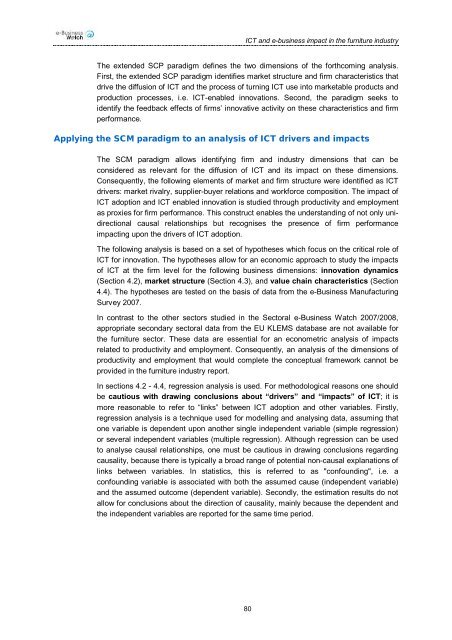ICT and e-Business Impact in the Furniture Industry - empirica
ICT and e-Business Impact in the Furniture Industry - empirica
ICT and e-Business Impact in the Furniture Industry - empirica
- No tags were found...
You also want an ePaper? Increase the reach of your titles
YUMPU automatically turns print PDFs into web optimized ePapers that Google loves.
<strong>ICT</strong> <strong>and</strong> e-bus<strong>in</strong>ess impact <strong>in</strong> <strong>the</strong> furniture <strong>in</strong>dustryThe extended SCP paradigm def<strong>in</strong>es <strong>the</strong> two dimensions of <strong>the</strong> forthcom<strong>in</strong>g analysis.First, <strong>the</strong> extended SCP paradigm identifies market structure <strong>and</strong> firm characteristics thatdrive <strong>the</strong> diffusion of <strong>ICT</strong> <strong>and</strong> <strong>the</strong> process of turn<strong>in</strong>g <strong>ICT</strong> use <strong>in</strong>to marketable products <strong>and</strong>production processes, i.e. <strong>ICT</strong>-enabled <strong>in</strong>novations. Second, <strong>the</strong> paradigm seeks toidentify <strong>the</strong> feedback effects of firms’ <strong>in</strong>novative activity on <strong>the</strong>se characteristics <strong>and</strong> firmperformance.Apply<strong>in</strong>g <strong>the</strong> SCM paradigm to an analysis of <strong>ICT</strong> drivers <strong>and</strong> impactsThe SCM paradigm allows identify<strong>in</strong>g firm <strong>and</strong> <strong>in</strong>dustry dimensions that can beconsidered as relevant for <strong>the</strong> diffusion of <strong>ICT</strong> <strong>and</strong> its impact on <strong>the</strong>se dimensions.Consequently, <strong>the</strong> follow<strong>in</strong>g elements of market <strong>and</strong> firm structure were identified as <strong>ICT</strong>drivers: market rivalry, supplier-buyer relations <strong>and</strong> workforce composition. The impact of<strong>ICT</strong> adoption <strong>and</strong> <strong>ICT</strong> enabled <strong>in</strong>novation is studied through productivity <strong>and</strong> employmentas proxies for firm performance. This construct enables <strong>the</strong> underst<strong>and</strong><strong>in</strong>g of not only unidirectionalcausal relationships but recognises <strong>the</strong> presence of firm performanceimpact<strong>in</strong>g upon <strong>the</strong> drivers of <strong>ICT</strong> adoption.The follow<strong>in</strong>g analysis is based on a set of hypo<strong>the</strong>ses which focus on <strong>the</strong> critical role of<strong>ICT</strong> for <strong>in</strong>novation. The hypo<strong>the</strong>ses allow for an economic approach to study <strong>the</strong> impactsof <strong>ICT</strong> at <strong>the</strong> firm level for <strong>the</strong> follow<strong>in</strong>g bus<strong>in</strong>ess dimensions: <strong>in</strong>novation dynamics(Section 4.2), market structure (Section 4.3), <strong>and</strong> value cha<strong>in</strong> characteristics (Section4.4). The hypo<strong>the</strong>ses are tested on <strong>the</strong> basis of data from <strong>the</strong> e-<strong>Bus<strong>in</strong>ess</strong> Manufactur<strong>in</strong>gSurvey 2007.In contrast to <strong>the</strong> o<strong>the</strong>r sectors studied <strong>in</strong> <strong>the</strong> Sectoral e-<strong>Bus<strong>in</strong>ess</strong> Watch 2007/2008,appropriate secondary sectoral data from <strong>the</strong> EU KLEMS database are not available for<strong>the</strong> furniture sector. These data are essential for an econometric analysis of impactsrelated to productivity <strong>and</strong> employment. Consequently, an analysis of <strong>the</strong> dimensions ofproductivity <strong>and</strong> employment that would complete <strong>the</strong> conceptual framework cannot beprovided <strong>in</strong> <strong>the</strong> furniture <strong>in</strong>dustry report.In sections 4.2 - 4.4, regression analysis is used. For methodological reasons one shouldbe cautious with draw<strong>in</strong>g conclusions about “drivers” <strong>and</strong> “impacts” of <strong>ICT</strong>; it ismore reasonable to refer to “l<strong>in</strong>ks” between <strong>ICT</strong> adoption <strong>and</strong> o<strong>the</strong>r variables. Firstly,regression analysis is a technique used for modell<strong>in</strong>g <strong>and</strong> analys<strong>in</strong>g data, assum<strong>in</strong>g thatone variable is dependent upon ano<strong>the</strong>r s<strong>in</strong>gle <strong>in</strong>dependent variable (simple regression)or several <strong>in</strong>dependent variables (multiple regression). Although regression can be usedto analyse causal relationships, one must be cautious <strong>in</strong> draw<strong>in</strong>g conclusions regard<strong>in</strong>gcausality, because <strong>the</strong>re is typically a broad range of potential non-causal explanations ofl<strong>in</strong>ks between variables. In statistics, this is referred to as "confound<strong>in</strong>g", i.e. aconfound<strong>in</strong>g variable is associated with both <strong>the</strong> assumed cause (<strong>in</strong>dependent variable)<strong>and</strong> <strong>the</strong> assumed outcome (dependent variable). Secondly, <strong>the</strong> estimation results do notallow for conclusions about <strong>the</strong> direction of causality, ma<strong>in</strong>ly because <strong>the</strong> dependent <strong>and</strong><strong>the</strong> <strong>in</strong>dependent variables are reported for <strong>the</strong> same time period.80
















